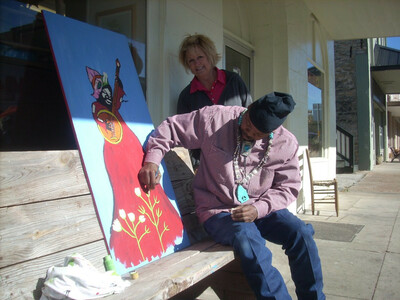Leon Collins "Sign of Peace"
-
- Leon Collins
- Birthdate Unknown
- Galveston / Navasota Texas Artist
- Image Size: 36 x 24
- Medium: Acrylic on Canvas
- 2024
- "Sign of Peace"
- Contact for Price & Info
- View All By This Artist
Details
Black Folk Art
 Portrait of John O. Meusebach. Image available on the Internet and included in accordance with Title 17 U.S.C. Section 107.
Portrait of John O. Meusebach. Image available on the Internet and included in accordance with Title 17 U.S.C. Section 107.Meusebach, John O. (1812–1897).Baron Otfried Hans Freiherr von Meusebach (John O. Meusebach), founder of Fredericksburg and peacemaker with the Comanche Indians, was born on May 26, 1812, at Dillenburg, Germany, one of the four surviving children of Baron Carl Hartwig Gregor von Meusebach, a judge solicitor, and Ernestine von Witzleben Meusebach. He attended the parochial school at Rossleben. In 1828 he enrolled in the Mining and Forest Academy at Clausthal in the Harz Mountains. In 1832 he enrolled at the University of Bonn, where he specialized in law, with cameralism and finance as supporting fields. During the course of his studies Meusebach learned to read five languages and speak English fluently. He eventually transferred to the University of Halle and took his bar examinations at Naumberg in 1836. Afterwards he worked in various administrative posts in Trier, Berlin, Potsdam, and elsewhere.
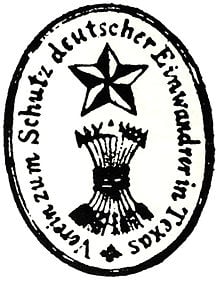 The logo for the Verein zum Schutze Deutscher Einwanderer in Texas, otherwise known as Adelsverein. Image available on the Internet. Image available on the Internet and included in accordance with Title 17 U.S.C. Section 107.
The logo for the Verein zum Schutze Deutscher Einwanderer in Texas, otherwise known as Adelsverein. Image available on the Internet. Image available on the Internet and included in accordance with Title 17 U.S.C. Section 107.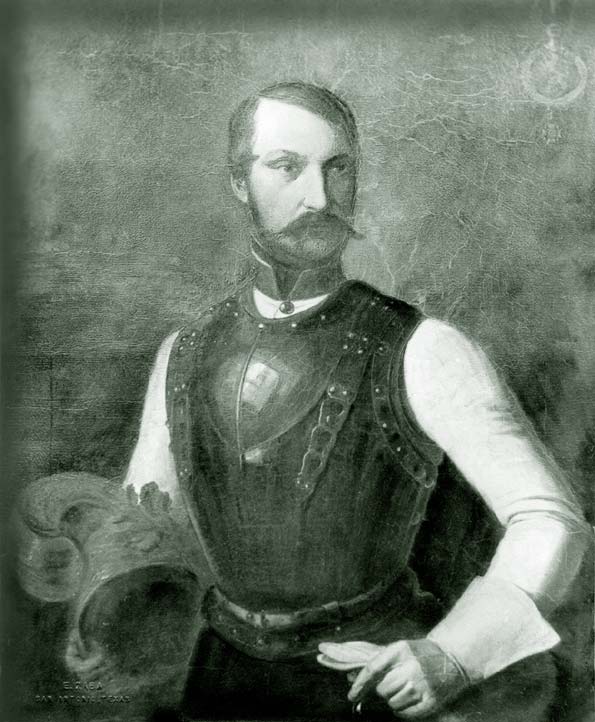 Illustration, Portrait of Prince Carl of Solms-Braunfels. Image available on the Internet and included in accordance with Title 17 U.S.C. Section 107.
Illustration, Portrait of Prince Carl of Solms-Braunfels. Image available on the Internet and included in accordance with Title 17 U.S.C. Section 107.In 1845 the Society for the Protection of German Immigrants in Texas, the Adelsverein, appointed Meusebach to succeed Prince Carl of Solms-Braunfels as its commissioner general in Texas. As executive administrator for the Adelsverein, Meusebach received an allowance of $2,000 for the purchase of scientific equipment, a salary of $790 annually, a commission of 2 percent of all net profits of the society, and an allocation of 500 acres of land. If the society should dissolve within five years, he was to receive an indemnity of $5,000. In early May of 1845 Meusebach arrived in Galveston. He and his small entourage rode horseback to New Braunfels, 165 miles away, finishing the trip with six overnight stops. Meusebach labored to serve the needs of the new immigrants with a diligence true to the motto on his family's crest, "Tenax Propositi" ("Steadfast in Purpose"). However, indebtedness, lack of cash, the arrival of too many immigrants in too short a time, the shortage of the necessary vehicles for transporting them to the interior of Texas, the outbreak of war with Mexico in the immediate disembarkation area, the unexpectedly severe winter, and disease of epidemic proportions all hampered his efforts. Nevertheless, while he took charge of the affairs at New Braunfels he also founded the settlements of Fredericksburg, Castell, and Leiningen.
 Map of Fisher-Miller Land Grant. Image available on the Internet and included in accordance with Title 17 U.S.C. Section 107.
Map of Fisher-Miller Land Grant. Image available on the Internet and included in accordance with Title 17 U.S.C. Section 107.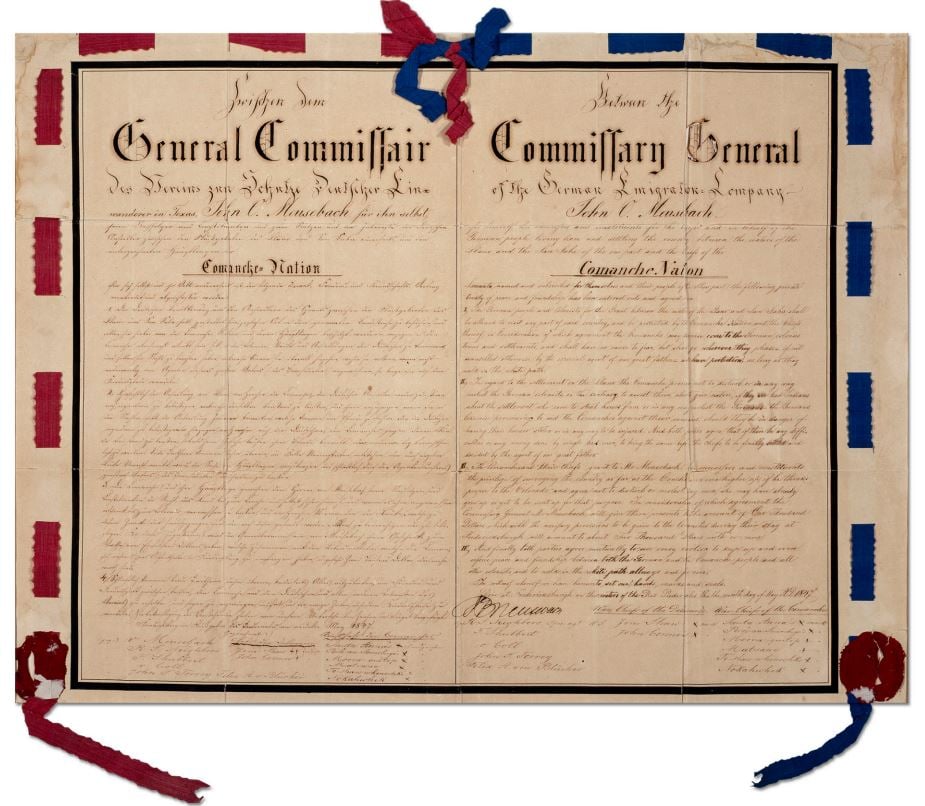 Photograph, Meusebach-Comanche Treaty. Image courtesy of Texas State Library and Archives Commission. Image available on the Internet and included in accordance with Title 17 U.S.C. Section 107.
Photograph, Meusebach-Comanche Treaty. Image courtesy of Texas State Library and Archives Commission. Image available on the Internet and included in accordance with Title 17 U.S.C. Section 107.Soon after his arrival in New Braunfels, Meusebach put aside his German title of nobility and adopted the name John O. Meusebach. Convinced that use should be made of the land in the Fisher-Miller Land Grant, he acquired headrights in it on credit. Before surveying and settlement of the site could occur, it was necessary to arrive at an agreement with the Comanche Indians. In December 1846, speaking through Indian interpreter Jim Shaw, Meusebach arranged to meet with ten Comanche chiefs on the lower San Saba River in early March 1847. Despite current reports that the Comanches were on the warpath, Meusebach and a delegation of German settlers met with the head chiefs-Buffalo Hump, Santa Anna, and Mopechucope (Old Owl)-and their people. He promised the Indians presents worth $3,000 in return for the Indians' pledge not to disturb the surveyors or harm the colonists. On May 9, 1847, the Comanche chiefs came to Fredericksburg to sign the Meusebach-Comanche Treaty and collect their gifts. This treaty was one of the most important pioneer works of the Germans in Texas. After it, in July 1847, thinking that his work for the society was complete, Meusebach gave up the office of commissioner general.
Among Meusebach's close associates in Texas were botanist Ferdinand Lindheimer and geologist Ferdinand von Roemer. He also corresponded and exchanged native plants with George Engelmann, founder of the Missouri State Botanical Gardens. With Engelmann as his intermediary, Meusebach annually supplied from his land in Central Texas thousands of cuttings of native black Spanish grapes to replace the phylloxera-ravaged plants of French vineyards. He also supplied Texas yucca plants to the American and foreign markets. At least once Engelmann provided Meusebach with Catalpa speciosa seeds.
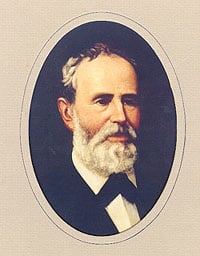 Portrait of Elisha Marshall Pease. Image courtesy of the Texas State Library and Archives Commission. Image available on the Internet and included in accordance with Title 17 U.S.C. Section 107.
Portrait of Elisha Marshall Pease. Image courtesy of the Texas State Library and Archives Commission. Image available on the Internet and included in accordance with Title 17 U.S.C. Section 107.While on a trip to Germany in 1851, Meusebach was elected to the Texas Senate to represent Bexar, Comal, and Medina counties. He was a member of Senate committees on state affairs and education, where he advocated universal and compulsory education. In early 1852 the education committee got a bill passed to provide for a system of public schools. In 1854 Meusebach received an appointment as commissioner from Governor Elisha M. Pease to issue land certificates to those immigrants of 1845 and 1846 who had been promised them by the Adelsverein.
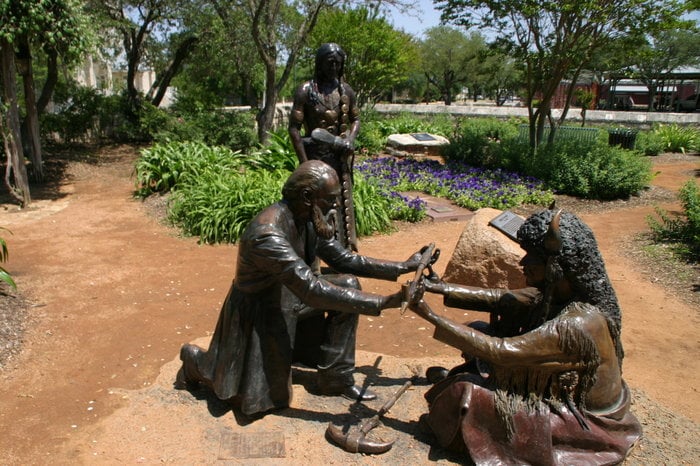 Photograph, Memorial to Meusebach-Comanche Treaty. Image available on the Internet and included in accordance with Title 17 U.S.C. Section 107.
Photograph, Memorial to Meusebach-Comanche Treaty. Image available on the Internet and included in accordance with Title 17 U.S.C. Section 107.Meusebach lost his first fiancée, Elisabeth von Hardenburg, to typhoid fever. On September 28, 1852, he married seventeen-year-old Countess Agnes of Coreth. They had eleven children, of whom three sons and four daughters reached adulthood. Meusebach retired to his 200-acre farm in Loyal Valley in 1869 and spent his remaining years tending his orchard, vineyards, and rose garden. He died at Loyal Valley on May 27, 1897, and is buried at Cherry Spring, near Fredericksburg.
-
-
Biography
Leon Collins Birthdate Unknown
Leon Collins (Texas Artist)
Leon Collins Birthdate Unknown
“The inspiration comes from my great, great grandmother...the will comes from God.”
______
Leon Collins was born in Galveston. At the age of four, he was sent to live with relatives in Baton Rouge. At eight he moved to Beverly Hills, California to live with his mother. Each summer he was sent to Brazoria, Texas to stay with his great-great-grandmother, “Big Mama.”
“Big Mama,” who lived to be 114, told him stories which he recorded in his Big Chief notebook. When Leon’s mother passed away, Leon moved from California to Texas where his mother’s sister lived.
“If God gives me my sight back, I’m going to start painting again.”
For two years Leon’s daughter Molly Bee was his caretaker when he was afflicted by brain cancer in 2005. In 2007, his sight returned. He kept his promise to God.
Before returning to his art, Leon spent time as a picker of antiques. One antique store saw some of Molly Bee’s paintings and quickly sold them at his shop. Both Leon and Molly Bee were quickly in the art business. Word of their “folk” art quickly spread. Their paintings hang from coast to coast. Recently Rice University recognized their art with the exhibit "The Color of Life."
Of his artwork, Leon Collins said: "Ninety percent of my work comes from God and Big Mama.”
Leon’s and Molly Bee’s Updates:
Leon and Molly Bee Collins have exhibited at the Main St. Fort Worth Arts festival.
That opening is special for two reasons. This was a father / daughter exhibition, and this is their first show in an art gallery. The Texas artist’s work is from their hearts and imaginations. Neither is trained as an artist, instead their paintings are "recollections” of stories, events, places, characters and ideas brought to life in brilliant color.
Information for the Festival read: "Leon’s need to paint came about because of an “unusual life situation. "One morning Leon lost the ability to speak and his sight. For two years he lived in darkness and fear. He never lost his faith though. Miraculously both returned at the same time. It was at that moment he decided to paint “to keep the darkness away.” His daughter, Molly Bee, encouraged him to paint his poetry and that is why she is the light of his life.
Molly Bee acquired her nickname at the age of two. Named after Leon’s great-great grandmother’s sister, the first Molly Bee lived to be 119 and died in 1970. Her first memory was of seeing her parents chained together at a slave auction. She lived a rich, full life that she shared with Leon. It was these stories that Molly Bee began to paint in her own style at the age of nine.
Source:
"Leon Collins," Old Art Guy,
Leon Collins does a kind of folky-edgy/borderline unsettling art and cannot keep his work in stock. Leon produces art like a madman with a gun to his head. He many times paints one painting a day. A LARGE painting. That includes prep work and framing (on occasion) and annoying me occasionally when he gets restless. He does not have time to think a thought. He paints what he sees, what he dreams, what he remembers, anything that comes to his mind. There is often no symbolic theme, no deep story behind his works, no mission, no central message; A little girl avoids the jaws of an alligator, a man ducks his wife’s rolling pin, black women sail through a cotton field dragging enormous sacks… A crazy looking bird watches… you don’t know what it is… He is as purely stream of conscious as I have ever known.
Almost everything Leon Collins does is the antithesis to whatever any artist or professor or knowledgeable person has ever told me. And yet his sales outstrip whatever might be second. We talk all the time about the hows and whys... Leon's work and its success is a perfect storm, the juxtaposition of local color, black culture, popular fantasy, and the white need to prove something. He is thriving purely because he offers a product that hits this culture right between the eyes… and they do not even know why. Ever since Picasso's Guernica, art has denied the soul. But when people meet Leon Collins, they seem to discover theirs. He is the high priest of racial atonement, and his sidewalk easel the confessional. And he has won thousands of converts.
He came to an art studio over thirty years ago, and explained he was an artist and wanted to pursue an art career, the studio took an interest in him and encouraged him. At the time another black artist, David Woods was setting the brush on fire with his black genre art, and I knew there was room for more. Then later one day I met him walking down the street, (he never drives, never had a car, ever) and he was carrying some antique fire buckets he wanted to sell. He was not painting, but had found he could make out better as an antique "picker." I purchased quite a bit from him over the years, always talking about his talent, and him pretty much ignoring my advice.
Now it is the other way around.
Then around twenty years ago another artist, Junior Tennyson came up with an idea that inspired Leon and soon he was exhibiting in Bryan and even Dallas. You may wonder what inspires him, and it is simple: making money. His black and white ink drawings sold pretty well... better than me for sure. Then he got bored with it and set aside painting for several years and went back to antique picking. When his daughter Molly, whom I have known since she was a little monkey that would climb me like a tree and take off my glasses, began to paint several years ago, he picked it up again. Especially when he saw how well people received her work. Leon has always loved the action of trading. And he responds to friendly competition too.
He and Molly began. They painted on boards, doors, even over other artworks.
Leon has had a ball. He has never gotten all wrapped up in art talk or concern about materials or framing or anything. His may be the most pure, unpretentious art I have seen made. He gets a thought, and within hours it is drying in the sun. His works are composed without much research or visual resources, and he depends a great deal on his imagination and his personal experience. If he finds an old closet door, or a canvas screen, he paints on it. One day he is painting bluesmen, the next cowboys and Indians. One day Texas missions, the next day slaves in bondage. He does whatever appeals to him, unrestrained by the academic structure of design, drawing, or proportion. Or "good taste." If his colors seem garish and his subjects edgy, then too bad. That's what he did that day, no apologies. The off-the-wallness of his work seems to be part of the charm. He makes no pretense about what he makes or what it might be worth.

